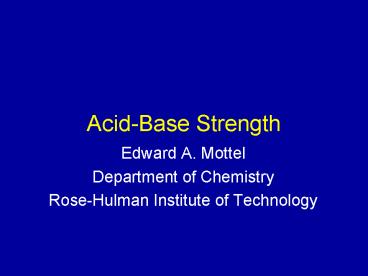AcidBase Strength - PowerPoint PPT Presentation
1 / 40
Title:
AcidBase Strength
Description:
The strength of an acid is a measure of its ability ... bitumen. H2. Superacid (gaseous) lower boiling distillate. also, coal liquifaction. Redox Reactions ... – PowerPoint PPT presentation
Number of Views:262
Avg rating:3.0/5.0
Title: AcidBase Strength
1
Acid-Base Strength
- Edward A. Mottel
- Department of Chemistry
- Rose-Hulman Institute of Technology
2
Acid-Base Strength
The strength of an acid-base interaction depends
on the nature of the reacting species and solvent
effects.
Solvent effects can be eliminated by
considering gas phase reactions.
The strength of an acid is a measure of its
ability to dissociate and protonate another
compound.
Non-aqueous solvents can be used to distinguish
between strong acids.
3
Gas Phase BasicityProton Affinity
An energy cycle can be used to determine the
strength of a base in the absence of solvent
effects.
-DHA,BH
B(g) H(g)
BH(g)
4
Gas Phase BasicitySubstituted Amines
proton affinity values
N3-
3084 kJmol-1
NH2-
2565
NH2-
1689
N(CH3)3
974
NH(CH3)2
954
NH2CH3
919
872
NH3
604
NF3
5
Solution Phase BasicitySubstituted Amines
NR3
The basicity of amines depends on
inductive effects of substituents
steric effects
solvent effects
NF3
N(CH3)3
NH2CH3
NH3
NH(CH3)2
no basic character
4.28
3.36
4.74
3.29
pKb
PA
604
974
919
872
954
6
Gas Phase AcidityProton Affinity
The conjugate base of stronger acids have lower
proton affinities.
DH PA
HF(g)
H(g) F-(g)
CH3COO- 1459 kJmol-1
CF3COO- 1351 kJmol-1
7
Gas Phase AcidityProton Affinity
I-
HI
1315 kJmol-1
Br-
HBr
1354
Cl-
1395
HCl
1459
CH3COO-
CH3COOH
1554
F-
HF
1635
OH-
H2O
8
Solution Phase AcidityAcid Strength in Solution
In water, HCl, HBr and HI are all
considered strong acids.
Why are they all considered equally strong in
water?
How can the strongest acid be identified?
9
Solution Phase AcidityAcid Strength in Solution
In which solvent would HCl ionize less?
H2O
NH3
CH3COOH
10
Acid-Base ReactionsIonic and Covalent
Contributions
Comparison of many acid-base reactions indicates
that both ionic and covalent factors contribute
to the enthalpy of reaction.
Each acid and base can be assigned an
electrostatic (E) factor and a covalent (C)
factor.
-?Hrx EAEB CACB
11
Acid-Base ReactionsIonic and Covalent
Contributions
-8.6
-1.3
-0.3 kcal/mol
-3.1
Which acid-base pair reactions are more
exothermic?
12
Acid-Base ReactionsIonic and Covalent
Contributions
-?Hrx EAEB CACB
These factors provide an estimate of the
enthalpy of reaction insight into the
bonding nature of each species
I - I
K
13
Acid-Base ReactionsIonic and Covalent
Contributions
-?Hrx EAEB CACB RATB
More precise estimates can include a correction
factor for the transference of charge from the
base to the receptor acid.
K
(more important for ions)
14
Acid-Base ReactionsIonic and Covalent
Contributions
-?Hrx EAEB CACB RATB
15
Acid-Base ReactionsIonic and Covalent
Contributions
E, C, R T values represent gas phase reactions.
F- has stronger ionic and covalent terms than
Cl-, Br- or I-
F- 9.73 4.28 37.40
Cl- 7.50 3.76 12.30
Br- 6.74 3.21 5.86
I- 5.48 2.97 6.26
16
Acid-Base ReactionsBond Energies
Three contributing factors to bond energy
covalent energy
Madelung (Coulombic) energy
electronegativity energy
-?Hrx EAEB CACB RATB
17
(No Transcript)
18
Hard and Soft Acids and Bases
Hard non-polarizable high charge density
Soft polarizable large, low charge
H, Groups I II, Ti4, Cr3, Fe3, Co3
Cu, Ag, Hg22, Hg2, Pd2, Pt2
cations
(class a)
(class b)
anions
NgtgtPgtAsgtSb OgtgtSgtSegtTe FgtClgtBrgtI
NltltPgtAsgtSb OltltSltSe?Te FltClltBrltI
19
Hard and Soft Acids and Bases
Dithiooxalate ion can chelate on two sides.
20
Hard and Soft Acids and Bases
Dithiooxalate ion can chelate on two sides.
-
-
S
S
O
O
C
C
Fe3
Cu
C
C
-
S
S
-
O
O
prefers softer cations
21
(No Transcript)
22
Superacids
More acidic than concentrated sulfuric acid.
Capable of protonating compounds that dont want
to be protonated.
Causing isomerization in the most unlikely
candidates.
23
(CH3)3COH
(CH3)3C H3O
I2
I2 and/or I3
24
Superacids
Acids which are stronger than pure sulfuric acid.
Super acids are measured with the Hammett
acidity function (Ho)
B is an indicator base e.g., nitroaniline,
benzene, picramide
25
Superacid Acidity
Ho
hydrofluoric acid HF -11.0
100 sulfuric acid H2SO4 -11.9
perchloric acid HClO4 -13.0
fluorosulfuric acid HSO3F -15.6
triflic acid HSO3CF3 -14.6
trifluoromethanesulfonic acid
magic acidTM HSO3F-SbF5 -21 to -25
fluoroantimonic acid HF-SbF5 -21 to -28
non-aqueous systems
26
(C6H5)3COH superacid ? (C6H5)3C H3O
trivalent carbocation (carbenium ion)
alkyl-Cl superacid ? alkyl HCl
hydrocarbon superacid ? hydrocarbon-H
pentacoordinate carbocation (carbonium ion)
George Olah 1994 Nobel Prize
27
Superacids
Formed by mixing
fluorine containing Bronsted acid or metal oxide
fluorinated Lewis acid
HF, HSO3F, HSO3CF3
BF3, SbF5, TaF5
TiO2, SiO2
28
Superacids
HSO3F SbF5
?
magic acidTM
fluorosulfonic acid
fluoroantimonic acid
Why are superacids so acidic?
29
Superacids
Hammett acidity is effectively the extension of
pH below zero.
BH ? B H pKBH
B is an indicator base e.g., nitroaniline,
benzene, picramide
30
Superacids
Hammett acidity is determined spectrophotometrical
ly by determining BH and B
B is an indicator base e.g., nitroaniline,
benzene, picramide
31
Applications
Isomerization/polymeriztion
R
Heterogeneous catalysts solid superacids ZrO2-SO4,
TiO2-SO4 for cracking isomerizing alkanes
32
Applications
Hydrocracking
lower boiling distillate
also, coal liquifaction
33
Redox Reactions
I2
peroxydisulfuryldifluoride
I2
SO3F -
I3
34
(No Transcript)
35
Superacids
HF SO3 ?? HSO3F
36
Non-aqueous Solvents
37
(No Transcript)
38
Acid-Base ReactionsIonic and Covalent
Contributions
K
-8.6
-1.3
-0.3 kcal/mol
-3.1
I - I
Which acid-base pair reactions are more
exothermic?
39
Superacids
Superacids
40
(No Transcript)































